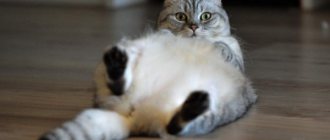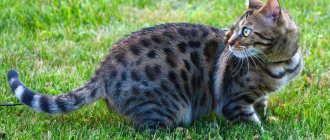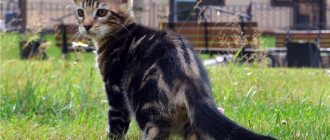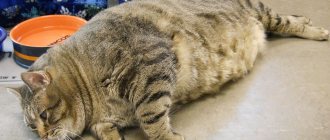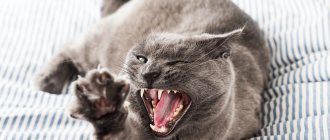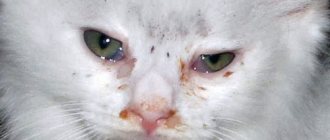The Cymric are long-haired, short-tailed animals very similar to the Manx. But unlike the latter, they have a luxurious fluffy coat. Thanks to their original appearance and friendly disposition, representatives of the breed are rapidly expanding their circle of fans.
However, before you decide to buy a Cymric, you need to learn more about the breed and the characteristics of keeping short-tailed cats.
Brief history of the breed
The British Isle of Man is considered the homeland of these animals, and the first mention of them dates back to 1750. Due to the fact that cats found themselves isolated from the whole world, they interbred with each other.
As a result, closely related matings led to the occurrence of a gene mutation, which manifested itself in a shortening of the tail. After some time, this sign was fixed in most cats and became their distinctive feature.
Those with short tails were identified as a separate breed and called Manx. Later, breeders began to notice that some litters produced kittens with long hair. Such animals were considered non-compliant with the standard and were discarded.
But in the 60s of the last century, shaggy short-tailed kittens came to Canada and began to be bred as a separate breed. The Cymric people received official recognition many years later. And some felinological systems still consider cats of this breed to be a type of Manx.
History of the origin of the breed
Perhaps it’s worth starting with the fact that the Cymric and Manx breeds are closest relatives with a rich history, which they share between them. Tailless cats have been found on the Isle of Man for over 400 years. They have almost become a tourist attraction; they even mint coins with their image. It is believed that cats “with a flaw” were brought to the British Isles from the Far East by sailors in the 16th century. Over time, their population increased significantly, the cats changed somewhat, but their characteristic feature remained unchanged - the absence of a tail. The breed was named Menx. As for Cymric, it is not so famous and popular, since it was officially recognized only in the 60-70s of the last century.
In the middle of the last century, along with the short-haired Manx, their long-haired variety began to be exhibited. These cats took part in many exhibitions and were noticed by Canadian breeders, especially Leslie Foltsake and Blay Welsh. They began to seek recognition of the new breed and granting it champion status. In 1976, the LovebunnyCatery organization allowed these cats to compete in the championship under their own name, Cymric. And by 1990, the breed was recognized by five more American associations.
The name of the breed, like the Manx, reflects its historical homeland: Wales
in Welsh "Cymru".
Cymric descended from Manx cats, so in appearance, character and even the genetics of the tail, they are very similar to each other. We can say that the Cymric breed was born naturally. Despite this, breeding it turned out to be quite difficult due to the lack of targeted selection work in the early stages of creating the breed and the genetic anomalies that the tailless gene entails.
Video: Cymrik kitten
Interesting Facts
Since the existence of Cymrik cats, many interesting things have been associated with them:
- There is a common joke among connoisseurs of these animals that they had rabbits in their family, which passed on the bobtail to them.
- The gene responsible for the absence of a tail can pose a threat to the life of a Cymric. If a kitten inherits it from both parents, it will die before birth and dissolve without a trace in the mother’s womb.
- The name of the breed comes from the English word cymric, which translates as “Welsh”.
Breed standards
One of the main distinguishing features is the complete absence of a tail. The presence of tail rudiments is undesirable.
The body of the Cymric is rounded. The back is rounded from the shoulders to the sacrum. The head, like the body, is rounded with prominent cheekbones. The eyes, located at an angle to the nose, are round and quite expressive. Their color depends on the color of the cat. Even disagreement is allowed. The ears, located high on the head, are wide and gradually tapering. The neck of these cats is massive with a characteristic “collar”. Cymriks have well-developed, massive limbs. The front legs are shorter than the hind legs.
Cats usually have medium to long hair. The fur on the back of the body may be longer than in the front. It is thick, silky and dense. Cymriki have a thick undercoat, which makes them appear even more rounded.
The most varied colors are allowed, except chocolate, lilac, and spotted.
Breed description, standards, appearance
Cymrik is a fluffy cat with a short tail, a powerful stocky body and strong bones. The requirements for its exterior are identical to the parameters of the Manx breed, with the exception of the point about the quality of the coat.
Dimensions and weight
Cymrik is a medium-sized cat with moderate sexual dimorphism. The weight of a male can reach 6 kg. An adult Cymri cat weighs no more than 4-5 kg.
Anatomical characteristics
Ideally, a Cymri cat should meet the following description:
- The head is round, slightly elongated, with developed cheekbones, a strong chin and a smoothly contoured forehead.
- The eyes are large and widely set. They have a rounded shape and a raised upper corner. The iris of a Cymri cat can be colored in any color that is in harmony with the tone of the coat.
- The ears are medium in size, with a wide base, rounded tips, and dense feathering on the inside and along the outer contour.
- The body is squat, tightly built, with developed muscles, a powerful neck, a low belly line and a short rounded back.
- The limbs are low, muscular, with large massive paws, in the interdigital space of which fur grows abundantly. The hind legs of the Cymric are much stronger and longer than the front ones.
- The tail is one of the most remarkable parts of the body of Cymri cats. Usually it is simply absent. But the breed standard allows for the presence of a small, non-protruding cartilage.
Depending on the length of the tail, there are 4 types of Cymri cats:
- rampi - completely tailless individuals;
- rampy-riser - with a short process of 3-4 vertebrae, covered with hair;
- stampy - with a short tail, on which there are knots and creases;
- longs - with a standard tail.
On a note. The Cymri Rampi cats are the most valued. Representatives of the breed with a long tail, which is free of defects, are often used for breeding.
Color and coat type
Cymrik is a long-haired cat breed with silky fur and developed down. The chest and neck of the animal are decorated with a rich “collar”. And on the hind legs of the Cymri cat there are small “pants”.
According to the standard, the fur coat of representatives of the breed can have almost any color. But most often the following colors are found in Cymri cats:
- plain (cream, red, black, blue and white);
- bicolor;
- silver chinchilla;
- smoky;
- tabby;
- mackerel;
- cake
On a note. The length and texture of the fur of Cymri cats can vary depending on the time of year.
Possible breed defects
Exterior defects, in the presence of which the Cymrik is not allowed to participate in exhibitions and is excluded from the breeding program:
- defects in the hull structure;
- congenital eye deformities;
- weak hind limbs;
- cryptorchidism;
- chocolate, Himalayan or lavender coat color;
- polydactyly.
What do you need to know about the Cymric, a cat breed with an unusual history?
The Cymric cat breed is distinguished by its pleasant appearance and balanced, friendly character. Representatives of the breed grow up to be smart, playful and loyal friends. Problems in care, if they arise, will be related to the health of the pet, which is caused by a genetic mutation.
History of the origin of the Cymric breed
The status of Cymric cats is still ambiguous: some felinological organizations and associations have already recognized Cymric cats as a separate breed, while others continue to consider them a variety of Manx cat. The first mention of the appearance of tailless cats dates back to the 18th century, when numerous intraspecific crossings on a limited territory of the Isle of Man led to a mutation - the absence of a tail. Initially, the birth of long-haired kittens from Manx cats was considered a deviation from the standard. Over time, the long-haired offspring obtained from Manx cats began to be used for breeding as a separate breed. The name of the Cymric cat breed comes from the English cymric, which means “Welsh”. However, modern animals do not have any connection with Wales. The main work on selection was carried out by Canadian felinologists in the 60-70s. last century. And the name was given to the breed to give it a Celtic flavor.
Description of appearance
Externally, Cymric cats are similar to Manx cats, but differ from them in having longer hair. The characteristics of the breed include: - strong muscular bones; - shorter front legs and powerful hind legs with tufts of hair between the toes; - medium-sized body with a short back and low abdominal line; - short and thick neck; - standard weight of an adult male is 4-6 kg, females - 3.5-4.5 kg; - missing or short tail.
Regarding the last parameter, felinologists distinguish 4 types of Cymrics: 1. Rampi (from the English rumpi). The tail is completely absent, which is why such animals look more spectacular than their other counterparts. 2. Rampy riser. Representatives of this type have a short tail of 1-3 vertebrae, which looks like a stump. Rumpy-Riser Cymrics are allowed to participate in exhibitions, provided that the hand of the judge stroking the animal does not touch the tail. 3. Stumpy. Stumpy cats have a short tail with various kinks and knots. Such animals do not participate in exhibitions, but are used as pets. 4. Longs. The longest-tailed of all Cymrics. To ensure that a healthy animal can find an owner in the future, many breeders practice tail docking by the end of the first week of life of tailed kittens.
All types of Welsh cats are involved in breeding, since mating only rampies after 3-4 generations leads to gene mutation and the appearance of genetic defects in the offspring.
Head and muzzle
Cymrik is a cat breed with compact sizes and rounded outlines. These cute animals have a rounded head with expressive cheekbones, a strong chin and large eyes. The eyes are set at a slight angle so that their inner edge is slightly lowered and the upper edge is raised. Eye color can be green, blue or copper, but a prerequisite is that it must be in harmony with the color. Wide-set, medium-sized ears with rounded ends are decorated with lush tassels, which gives the animal’s appearance a special charm.
Coat and color
Nature has endowed Welsh cats with a thick undercoat and dense, long, soft hair. It is evenly distributed over the body, but in the neck, belly and hind legs it is longer and silkier. Welsh cats are born with numerous color variations. International felinological organizations recognize almost all colors and patterns, with the exception of lavender, chocolate and Himalayan (with white spots).
Cat character
Cymrik is a breed of cats with a balanced character and a lot of positive qualities that people highly value in their four-legged pets: 1. Cymrik cats are faithful and devoted animals. They get along well with all family members and love spending time with people. Kymrik is able to devote all his free time to his beloved owner: he will relentlessly accompany him around the house, purr comfortably on his lap, or guard his sleep, sitting comfortably nearby. Frequent and prolonged absence of the owner for a long-haired pet is a terrible punishment. 2. Powerful hind legs allow cats to jump well and climb to any height. A cat tree or house on a high stand will make your pet happier and help protect furniture from damage. 3. Smart animals quickly figure out how to open a door or cabinet drawer to get what they want. They are easy to train and enjoy following simple commands. 4. Playful Cymrik cats have adopted one feature from dogs - they love to hide and bury their toys. 5. Long-haired pets love to watch running water from the tap and play with it. But the process of bathing itself does not bring much pleasure to the animals. 6. Kymriks get along well with cats of different breeds and non-aggressive dogs, so they can peacefully coexist in the same house with other four-legged family members. 7. The hunting instinct, which is in the genes of a furry pet, will make it the worst enemy of domestic parrots, decorative rats and hamsters. When a Cymrik lives simultaneously with small pets, you need to take care of the safety of rodents and birds. 8. Animals are not afraid of technology and car trips. 9. Welsh cats love to purr; their quiet voice with a range of interesting undertones is pleasant to the ear and does not cause irritation.
The Cymrik cat is reluctant to make contact with new and unfamiliar people and can become aggressive if it feels a threat to the owner. In order for a kitten to grow up to be a sociable, calm creature, it must be taught from an early age to travel and strangers.
Care and maintenance of the Cymrik cat
It is recommended to comb a long-haired cat at least 2-3 times a week, and every other day when the seasons change during spring and autumn shedding. This procedure will bring pleasure to your pet, help remove dead hairs and avoid the formation of tangles. The tenacious claws of your four-legged friend can damage a chair or sofa, but a store-bought or homemade scratching post will prevent damage to your favorite furniture. A smart cat will quickly figure out where to sharpen its claws, especially if the owner praises and rewards her for good behavior. To keep your pet healthy and looking well-groomed, it is necessary to follow standard hygiene procedures: - regularly brush your teeth, eyes and ears; — bathe with a special shampoo for long-haired cats; - change the contents of the tray in a timely manner.
You need to be careful when playing and interacting with animals. You should not grab a Cymric by the stump of its tail: in tailless cats, nerve endings are concentrated in this place, which, when pressed and subjected to strong impact, cause pain. When picking up an animal, you need to protect it from additional stress on its back and support its hind legs.
Nutrition
The Cymrik cat breed needs a balanced diet. The health of the pet and the beauty of its long, silky coat depend on the presence of nutrients (vitamins, microelements, proteins, fats, carbohydrates, polyunsaturated fatty acids, enzymes). The daily diet of a Welsh cat should include: - ocean fish; - bird; - lean beef; - vegetables; - fruits; - fresh herbs; - cereals; - cottage cheese; - fermented baked milk; - kefir.
The animal should not be overfed, so you need to learn how to correctly calculate the volume of the daily portion. Sweets, fried, peppered, salted and smoked foods are contraindicated for Kymriks: fish or meat should be given to the cat only in boiled form.
Health and life expectancy
The average lifespan of longhaired cats is 8-14 years. How long a four-legged friend will live depends on care, nutrition and set of genes. The gene responsible for the absence of a tail can give the kitten hereditary diseases characteristic of the breed: pathologies of the spine, disruption of the intestines and bladder. These diseases appear during the first months of the animal’s life, so reputable breeders euthanize sick kittens and sell healthy ones no earlier than 6 months of age.
How much does a Cymric cat cost?
It is almost impossible to buy a purebred Welsh kitten in our country. There are no nurseries engaged in breeding this breed in Russia or neighboring countries. Unscrupulous breeders and fraudulent sellers can pass off kittens of other breeds as Cymrics, having previously docked their tails.
Choice of kitten and price
The initial cost of a six-month-old kitten is 25-60 thousand rubles. The final price depends on the country of purchase, the trade policy of the nursery, gender, pedigree, wool quality and tail length.
What should you pay attention to?
The easiest way to buy Cymric is abroad. When going on vacation or traveling abroad, you can acquire a four-legged friend along the way. But first you need to contact the nursery and reserve a kitten. Before purchasing, it is advisable to check the condition of the tail and consult a veterinarian. Catteries engaged in breeding purebred cats issue special certificates confirming the health status of the animal. Therefore, it would be useful to require such a document. You should not adopt a kitten under 6 months of age, as in the first six months of life it may develop hereditary diseases that cannot be treated.
Conclusions about the breed
Breeding Cymrics is not an easy task and requires finding suitable parents. The main difficulty is that the gene responsible for the length of the tail leads to unwanted mutations in the offspring, the appearance of severe diseases of the musculoskeletal system and internal organs. You can only buy a purebred kitten abroad, since there are no breeders of Welsh cats in our country. But if you are suddenly lucky enough to buy a long-haired pet, then a sociable, flexible, friendly animal that is not prone to conflicts will appear in the house.
Character and temperament
Cymric cats are calm and balanced animals; they quickly become attached to people. Representatives of the breed are quite talkative and express emotions through interesting purring sounds. Sociable and sociable Cymrics do not like loneliness and prefer to spend time next to their owners.
The playful and gentle nature of a cat of this breed allows her to easily find a common language with children of different ages, especially if they do not try to offend her.
Cymriks do not start fights with their brothers and non-conflict dogs. But cats of this breed are prevented from making friends with decorative birds or rodents by their developed hunting instinct.
Is Cymric a calico cat?
Tricolor cats are also found among representatives of the Cymrik breed. This color usually goes to females; males with this color are born extremely rarely and are always fertile.
It must be said that the standard allows other colors for the Cymric that correspond to the original ones. Only colors such as colorpoint, chocolate, and lilac, obtained as a result of crossing with cats that have never lived in Wales, are considered atypical.
How to choose the right kitten
Those who want to become the owner of a purebred healthy Cymric should look for a kitten in certified foreign nurseries with a good reputation. When choosing a potential pet, you need to pay attention to the following characteristics:
- availability of documents;
- external compliance with the standard;
- behavioral characteristics;
- health status.
On a note. If a kitten of the Cymri breed looks lethargic and unhealthy, it is better not to purchase it.
Kitten care
Since kittens of the Cymri breed are reserved in good nurseries long before purchase, the owners have enough time to collect the “dowry”. The basic pet care kit includes:
- bowls for food and water;
- toys;
- tray with filler;
- bed or house;
- hygienic cosmetics (shampoo, ear cleaning lotion, etc.);
- grooming tools (combs, toothbrush, nail clipper, etc.).
In addition to “care” items, it is necessary to prepare the house. In the room where the little kimrik will live, wires, ornamental plants, detergents and breakable items are hidden. The kitten is also restricted from accessing open balconies and large household appliances. And special nets are installed on the windows for safety purposes.
Approximate cost of a Cymric cat and its acquisition
The cost of a purebred cat is largely determined by its pedigree, gender, length or absence of tail, color and many other parameters. The estimated cost of a cat can reach 2-5 tens of thousands of rubles or more.
Buying a Welsh cat is quite difficult. This is explained by the lack of nurseries for breeding this breed in Russia and neighboring countries. Before buying a kitten, you should carefully check the buyer for his integrity. You should not purchase a kitten younger than 6 months old. And it is better to examine it before purchasing from a veterinarian.
Popular kennels for this breed:
- Russia - (your nursery is here);
- Belarus - (take place);
- Ukraine - (submit an application).
Care and maintenance
Kymriki are unpretentious cats, so they easily adapt to different living conditions. It concerns basic hygiene, timely antiparasitic treatment and adequate feeding.
In order for the Cymri cat to look aesthetically pleasing, it is provided with proper care:
- The animal's eyes are wiped daily with a clean cloth soaked in herbal decoction or boiled water.
- The Cymri cat's ears are regularly cleaned of accumulated dirt and dust. A special product is instilled into each of them, and after a few minutes they are gently wiped with a cotton pad.
- As the cat's claws grow, they are carefully trimmed with a nail clipper so as not to touch living tissue. It is also recommended for the Cymric to purchase a special scratching post.
- Brush your cat's teeth several times a week with a soft brush or silicone brush with a small amount of non-foaming toothpaste. This simple procedure helps strengthen the animal’s gums and prevent the occurrence of dental diseases.
- The thick coat of the Cymric also requires careful care. In normal times, it is combed 2-3 times a week. During the molting period, the procedure is carried out more often. They bathe the Cymri cat once a quarter using shampoos for fluffy breeds.
Character
The ancestors of the Cymric were wonderful mousecatchers; modern cats have not lost these skills, along with independence and adaptability to different conditions. They can stand up for themselves and will defend their own territory, so at the slightest extraneous sounds, the cat will react quickly and may even show aggression.
With close people, the Cymrik will be affectionate and gentle. In his usual environment, he is a balanced and calm, moderately playful cat. Cymrik becomes very attached to the owner, will follow him around and show interest in household chores. The Cymrik kitten easily adapts to the surrounding conditions and easily tolerates moving or changing families, if necessary. Kymrik is equally well suited for both large families and single people.
As for intellectual abilities, the Cymric is not deprived of them. He quickly learns the rules of behavior, and if the owner wishes, he can even master a few tricks. The Cymric will also use his extraordinary mind for personal purposes, if necessary, learn to open doors or cabinets.
Feeding the cat
Food for Cymric should be well-balanced and sufficiently nutritious. It is important that it contains all the necessary vitamins and microelements and that there are no questionable additives. The following brands of dry food are best suited for Cymri cats:
- Pro Plan;
- Gemon;
- Pronature;
- Bosch;
- Eukanuba.
With a natural type of nutrition, representatives of the breed are selected a diet that contains 70-80% meat. Additionally, the Cymri cat is given:
- vegetables;
- porridge;
- offal;
- eggs;
- sour milk;
- ocean fish.
It is forbidden to feed the Cymric pork, onions, beans, potatoes, pastries, sweets, smoked meats and sausages. You should also not give your cat exotic fruits, river fish, fresh milk or any food from the owner’s table.
Proper nutrition
Due to its lifestyle, this breed has a predisposition to obesity. Taking this fact into account, you should carefully monitor your pet’s diet. Eating twice a day will be enough.
If you feed your pet dry food, do not forget to ensure that there is always fresh water in the drinking bowl.
If you like to pamper your Cymric with meat, then choose beef, chicken or rabbit meat. To avoid digestive problems, freeze fresh meat before feeding.
As for dairy products, the Cymric should not be pampered with them often for the same reason: to avoid digestive problems. It is preferable to give your pet fermented milk products.
Education and physical activity
Cymric cats are temperamental and jumping animals with a developed hunting instinct. They love to run, climb heights and participate in outdoor games. To satisfy the natural needs of cats, they are given several interactive toys and a sports corner.
Cymriks are smart animals with good memory and developed intelligence. They quickly get used to the tray and scratching post and easily learn the rules of behavior in the house.
On a note. Cymric cats have one interesting habit, more typical of dogs: like dogs, they like to hide or bury toys.
Cymric coloring
Welsh cats can have a variety of coat colors and patterns (see photo).
According to the standards of the Cat Association, the coloring for a Cymric should be as follows:
- White fur, blue, multi-colored or copper-colored eyes.
- Blue.
- Black.
- Red or cream color.
- Silver chinchilla color.
- Smoky silver.
- Smoky with a black or blue tint.
- Various tabbies (stripes), namely the blue, silver, red, brown and mackerel varieties.
- Two-color.
- Stripes of different shades with white.
- The association considers the following colors to be different from the standard: chocolate, lavender or Himalayan, which may include white spots.
Vaccinations and antiparasitic treatment
Keeping a dog at home is not a guarantee that a Cymrik will not contract a viral or infectious disease. To protect a cat from panleukopenia, calcivirosis and rhinotracheitis, it is systematically vaccinated with a complex drug. The first vaccination is given to a kitten at the age of 7-8 weeks.
After 28 days, the Cymric is re-vaccinated against the same diseases and against rabies. In the future, the cat is vaccinated annually.
Twice a year, Cymric is subjected to antiparasitic treatment. The dose of medications for fleas and helminths is selected taking into account the weight of the cat.
Cymric health
As a native breed, the Cymrik is unusually strong, resilient and healthy. He does not suffer from any heart disease, is not susceptible to infections or colds, and has no intestinal problems.
However, the Cymrics are characterized by some deviations associated with the structural features of their body; This:
- A mutant gene that is responsible for taillessness in Cymrics. It is recessive and penetrative (that is, it may or may not be present in both anurans and caudates). To give birth to healthy kittens, one of the parents must not be a carrier of the gene. If both are carriers, then the offspring will be born dead.
For the birth of healthy offspring from a Cymric, competent selection is important
- Manx syndrome is a dangerous disease that can appear in kittens from birth to 6 months. It manifests itself in shortening of the spine, which leads to hernia, fusion of vertebrae and many other problems. Tailed Welsh cats are much more susceptible to this syndrome. Therefore, breeders often dock the tails of kittens at the age of a week. They do this for other reasons: in tailed Cymrics, at the age of 4–5 years, the spine may stiffen. Cupping at this age is dangerous, but kittens tolerate it without complications.
Manx syndrome affects kittens under 6 months of age
Pros and cons of the breed
Although Cymrics have many distinct advantages, they also have disadvantages that should be considered when deciding whether to purchase one.
| pros | Minuses |
| Pleasant appearance | Rarity of the Cymri breed |
| Cleanliness | Predisposition to Manx syndrome |
| Loyalty to children |
Kymrik is a charming cat with a friendly, easygoing disposition and active temperament. He is not prone to conflicts and is ready to become a loyal friend to someone who surrounds him with warmth and care.
Photos of Cymrik cats
Read here Turkish Van - 125 photos, video description of appearance and standards, character typical of the breed
Help the site, share with friends 
Temperament of the Welsh cat
Cymrik is a smart, quick-witted cat, has a playful disposition and a bit of fearlessness. Historically, Welsh cats lived on the island, ate rodents, and their hunting skills were fully passed on to modern representatives of the breed.
If suddenly there are mice in the house where the Cymrik lives, they won’t have to manage it for long, the cat will quickly deal with this “brotherhood”. He deftly tracks down prey and rushes at it with lightning speed. Breeders claim that a Cymric can rush not only at a rat or mouse, but also at a larger animal if it senses aggression coming from it.
Kymrik easily adapts to the temperament and regime of its owners. If a pet lives in a house where there is always peace and order, it behaves calmly, and when the owners have no time, it goes to bed.
If there are children in the family, he is not averse to playing and fooling around. The Welsh cat loves to climb higher and look down on the surrounding household members. The Welsh cat loves free space; if possible, purchase a cat corner with special trees and a climbing pole. Kimrik easily goes for walks on a leash and goes on trips with his owners without worry. The Cymrik does not tolerate loneliness well, so think twice before getting such a cat if no one is home most of the day.
Buying a kitten
There are no nurseries dealing only with Cymriks in Russia. To choose a worthy representative of the breed, you will have to fly overseas or find a nursery in Europe on the Internet - there are at most one or two of them. When purchasing, you should not be guided by the appearance of the kittens - the absence of a tail or a very short tail is not a clue in determining the breed. A reputable breeder will not sell a Cymric without a contract, which will stipulate, for example, mandatory castration/sterilization or participation in exhibitions in the advertising class.

